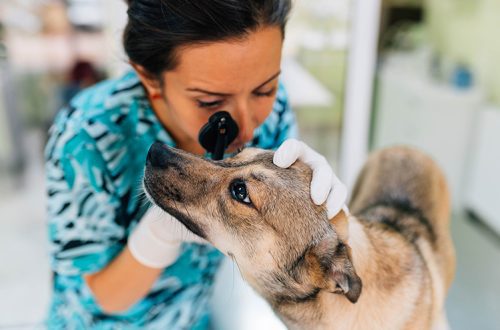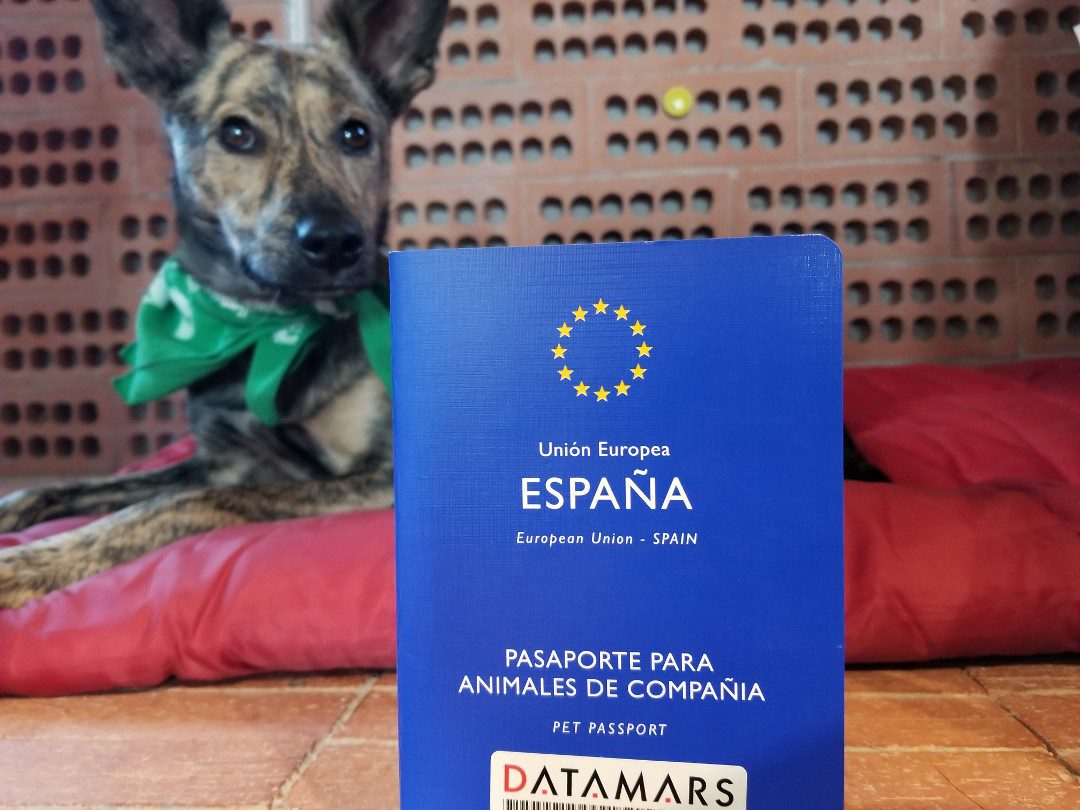
Veterinary passport for a dog – what is it and how to get it?

The Petstory editors explain what a veterinary passport for a dog is, how to make it correctly and what documents to issue in order to take your pet with you on vacation.
Contents
Why do you need a veterinary passport for a dog?
A veterinary passport is needed to transport a pet by plane and train, to participate in exhibition competitions and for sale. If you are going on vacation without your pet, then without a passport you can leave it only with friends. Official overexposures and hotels do not accept animals without passports.
And even if your pet is a homebody, still issue him a document. In the veterinary passport, the veterinarian writes down all the dates of vaccinations, treatments for parasites and surgeries. You do not have to remember when you did this or that vaccination and whether you did it at all. The passport will serve as proof that your pet has been vaccinated against rabies. This will help in conflict situations if the dog bites someone. And the most important plus: if you have a passport, you can always prove that this is your pet. Below we will look at how to fill out a veterinary passport for a dog.
Is it necessary to issue a passport?
Officially in our country there is no law requiring a passport for a dog. But you will not be able to carry out the official transportation of a pet without this document.
Internal veterinary passport
We will find out how much it costs to make a dog passport and what information it contains, as well as see a sample dog passport.
Veterinary passport is issued free of charge, the form itself costs from 100 to 300 rubles. The price depends on the appearance and quality of the paper.
The passport states the following:
pet photo;
owner data (name, address, phone number);
description of the dog (name, breed, date of birth, gender, color, special features);
vaccinations and parasitic treatments;
identification number (chip or stamp number);
additional medical data (diseases, operations, estrus and mating dates, number of puppies born);
for pedigree dogs, the pedigree number, breeder, brand or chip number are indicated.
In the field on vaccinations and treatments, the veterinarian writes down the date, the name of the drug, attaches a sticker with the series and number of the drug. Manufacturers put stickers in some tablets. You can stick them on yourself and write down the date when the dog was treated. But to transport a pet, you will need the seal and signature of a doctor. In this case, visit the vet.
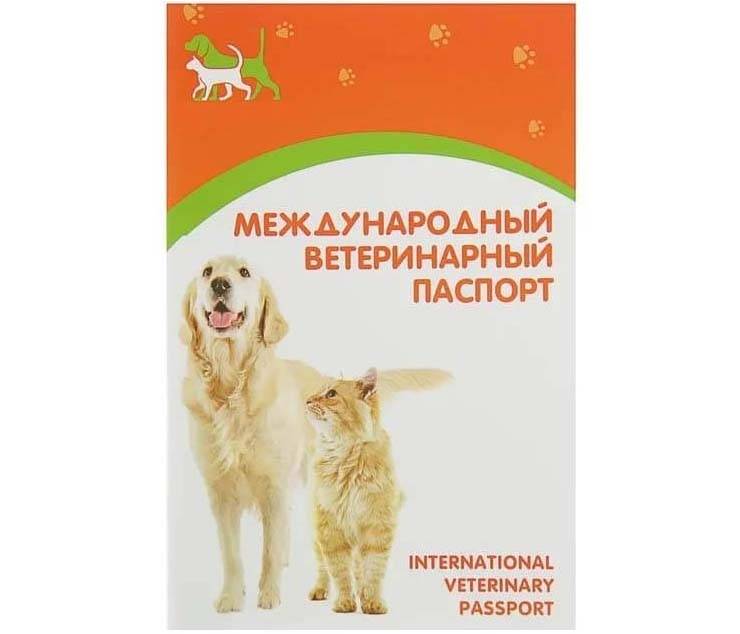
This is what a dog passport might look like. Ozon.ru
International Veterinary Passport
The international veterinary passport for dogs looks almost the same as a regular one. But all items are additionally written in English.
Dogs must be microchipped to travel abroad. This way you identify the animal and prove that you are its owner. According to international standards, a passport can only be issued for an identified dog.
There are also requirements for rabies vaccination. Your pet must have received it within the last 12 months. If you have not vaccinated your dog, do so at least 20 days before departure. Only after that you can chip the dog so that the vaccination data is stored in the medical database by the chip number.
For international travel, only a passport is not enough. Carefully study how to properly import a dog into the country you are going to. Also call the departure airport and ask for their transportation requirements. Some countries may have quarantine requirements for dogs arriving in the country. Sometimes it reaches three weeks. The UK has the strictest conditions.
Also, some countries may require that your pet be spayed if it is not of breed value.
Fill in all items in a clear, understandable handwriting without corrections.
Alternative Documents
The Rosselkhoznadzor website provides the following list of documents for traveling with a dog: vetpasport with data on all vaccinations and studies or veterinary certificate form No. 1 or veterinary certificate of the Customs Union form No. 1 when traveling to Belarus, Kazakhstan, Armenia and Kyrgyzstan.
Issue a veterinary certificate form No. 1 or a veterinary certificate of the Customs Union form No. 1 immediately before the trip at state veterinary clinics, as they are valid for 5 days. These documents are issued free of charge.
To receive, you must provide:
dog for examination;
passport, where the dates of treatments and vaccinations are recorded;
a mark on the treatment against echinococcosis (tapeworms);
the result of a scatological study for helminthiases;
requirements of the importing country into which the animal will be imported.
To obtain documents, start preparing the dog in advance. Visit a veterinarian 30 days before departure. If it is a private clinic, then it must have permission to vaccinate animals against rabies. After 30 days, visit the doctor again at a public clinic to receive a certificate or certificate.
To find out the veterinary requirements of the country you need, fill out the online form on the Rosselkhoznadzor website.
You may also need additional documents for travel. In the requirements for traveling to EU countries, you can see evrospravka, and for other countries – certificate form No. 5a or documents agreed between Rosselkhoznadzor and the country of entry. To get them, contact the territorial department of Rosselkhoznadzor.
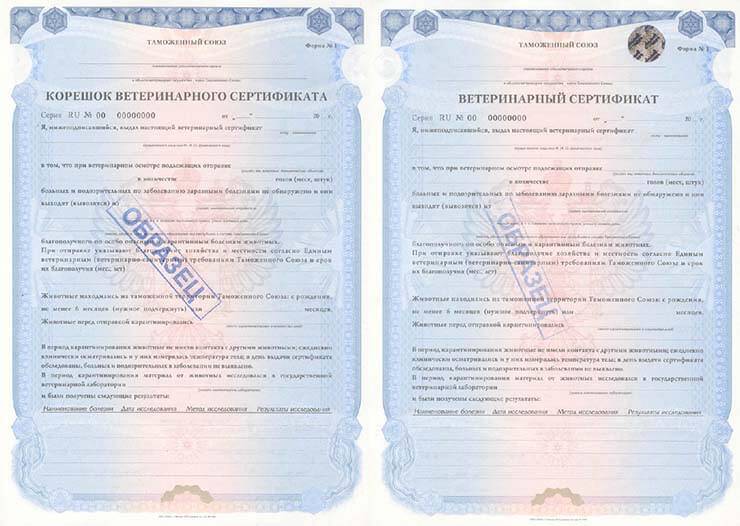
Sample veterinary certificate form No. 1
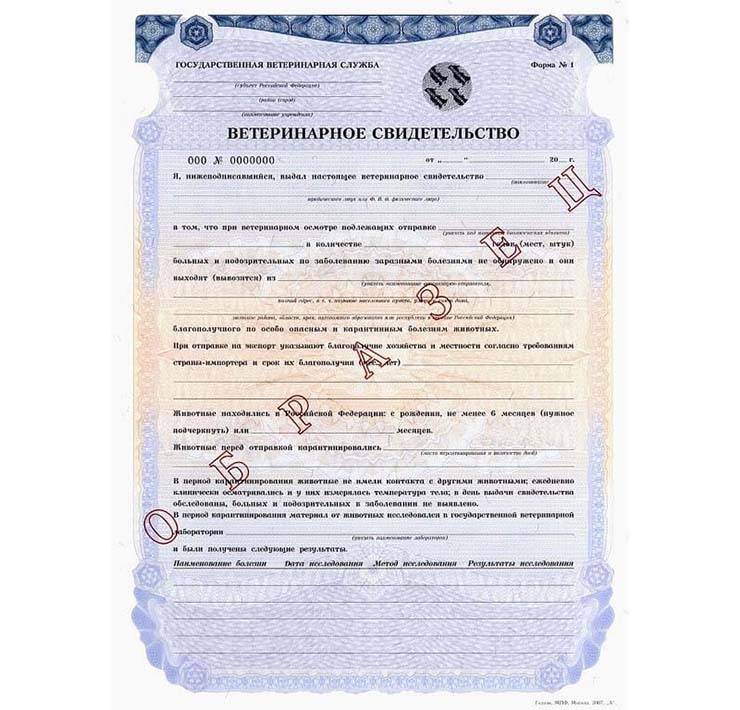
Sample veterinary certificate of the Customs Union No. 1
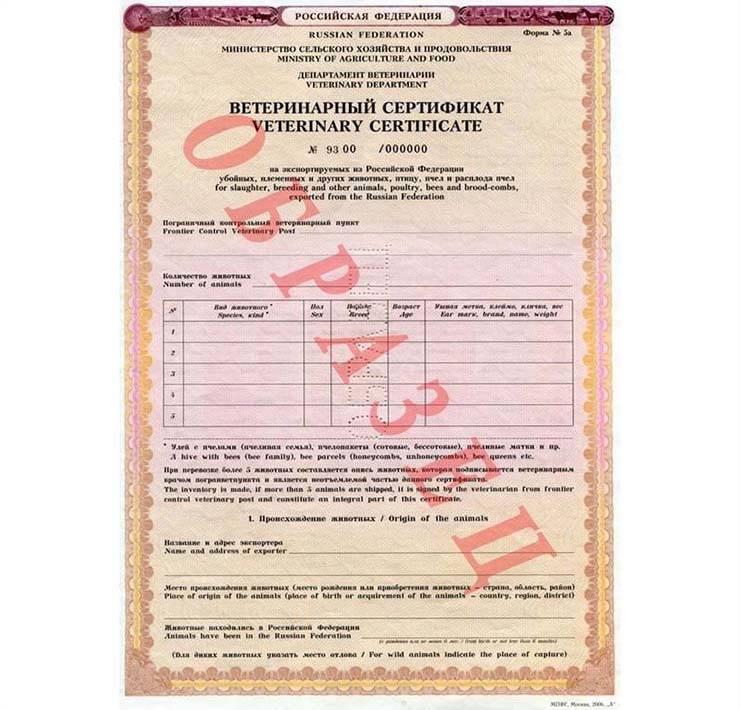
Sample certificate form No. 5a
Next, we will learn how to make a passport for a dog.
How to get a passport for a dog
With the official purchase, the breeder must provide you with a dog’s veterinary passport with marks of the first vaccinations. In other cases, a passport will be issued to you when visiting a veterinary clinic. You will need to pay for the document itself. Veterinary passport forms are also sold at pet stores. You can come with the form to the veterinary clinic, the doctor will explain how to issue a passport for the dog.
How to fill out a dog veterinary passport – a sample
Now we will look at how to fill out a dog passport correctly.
To travel abroad, all information must be entered or duplicated in English, the name of the animal must be indicated in Latin. The passport should not have torn pages. Fill out your passport in block letters with a black or blue pen.
You can enter some of the information yourself, vaccination marks and animal identification are filled in by a veterinarian.
The photographs below show an example of filling out a dog passport.
dog owner
Enter the name of the owner of the dog, his address.
Please note that there are several fields available for filling. A dog can have multiple owners. If a member of your family takes a dog on a trip, it must be included in the veterinary passport.
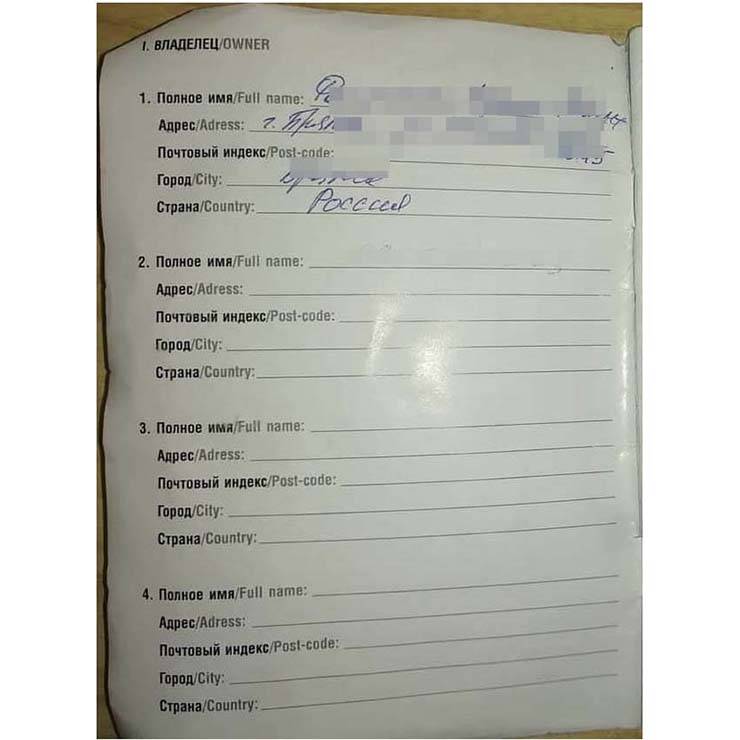
Dog description
Enter the dog’s name, date of birth, breed. Write the breed only if you know it for sure. If your dog is not purebred, then you need to write “mestizo”. Next, indicate the gender: female or male. Next, designate the color of the dog. Write down the exact color if you know. If not, describe it yourself: black, black and white, red, etc.
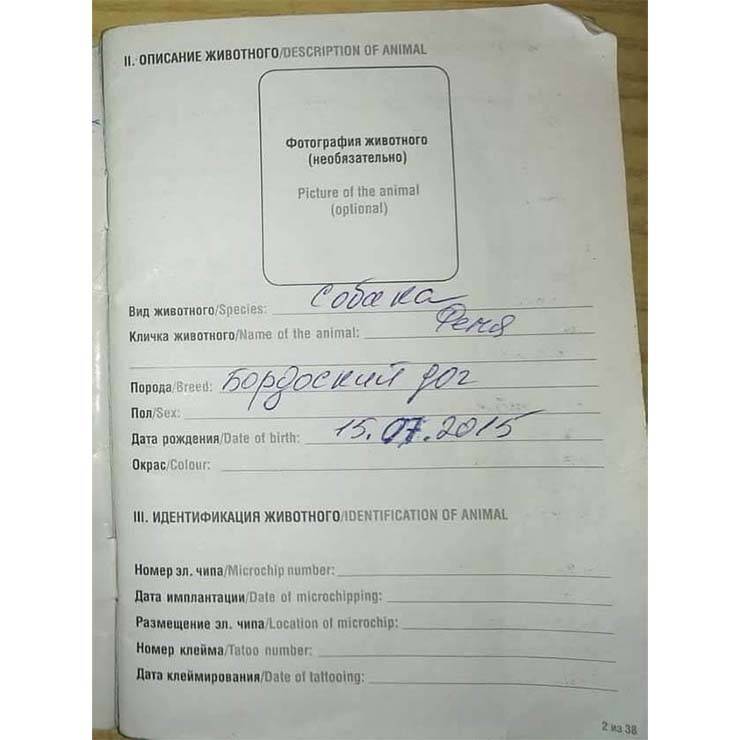
Deworming and treatment against ectoparasites
Complete this section if you are giving your dog deworming and tick tablets. Indicate the date and name of the drugs. If the processing is carried out by a doctor, then he himself will enter all the information.
Vaccination Information
The items “Vaccination against rabies”, “Other vaccinations” will be filled in by a veterinarian.
Pay attention to how the doctor completes the vaccination sections. He must indicate the date, stick a sticker with the name of the drug, sign and seal.
Below is a sample of how to fill out these pages in the veterinary passport for a dog.
Veterinary passport validity period
The veterinary passport is valid throughout the life of the animal. It doesn’t need to be reissued. If your pet’s passport is accidentally damaged, replace it. When crossing the border, only the whole document is valid, without torn pages and corrections.
What to do if you have lost your passport
The most important thing in the veterinary passport is information about the last vaccinations for the year. If you have not done them to your pet, then you can simply get a new veterinary passport when contacting a veterinarian. To restore complete information, contact the veterinarian where the pet is usually seen. Data on rabies vaccinations and required vaccinations due to outbreaks of infectious diseases are kept in the general register for at least 5 years. And once a quarter, clinics submit data to Gosvetnadzor, where they are stored for at least 10 years.
If your dog is microchipped, the data will be easier to recover. It can be extracted from the EDB – a single database. Have your doctor enter the pet’s chip identification number into the EDB. On subsequent visits to the veterinarian, find out if he has entered data on the manipulations performed.
Additional documents
If you have a purebred dog and plan to participate in exhibitions, then you will need additional documents. They can be issued in the RKF – Russian Cynological Federation.
What can be issued in the RKF:
pedigree;
working certificates confirming that the dog has qualities corresponding to its breed;
breeding certificates indicating that the animal fully complies with the breed standards and can be used to reproduce the offspring of this breed;
diplomas of the participant of national exhibitions;
diplomas of international champions;
certificates of passing kyorung;
certificate of international standard on the absence of dysplasia based on the results of testing the elbow and hip joints;
certificate Patella.
Separately, consider the puppy’s passport – it is correctly called the puppy metric. The metric is necessary to obtain a pedigree, filled in Russian and English. It is issued by a cynologist after examination and evaluation, when the puppy is 45 days old. Please note that the metric does not give the right to participate in adult shows and breeding. This is an intermediate document about the puppy’s belonging to a particular breed. It is better to exchange the metric for a pedigree before the puppy is 15 months old.
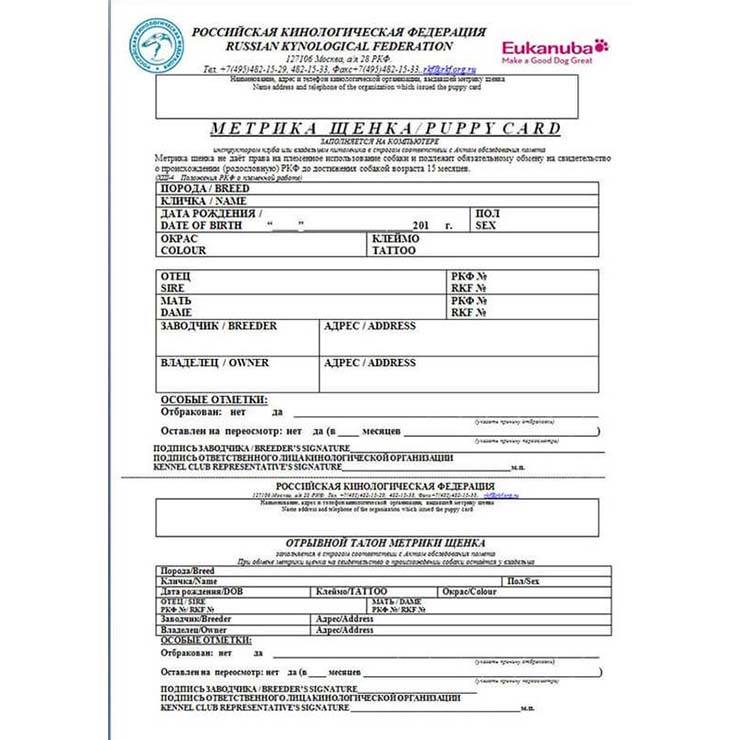
This document indicates key information about the puppy:
breed;
alias;
Date of Birth;
information about the breeder;
data on the origin – about both parents and place of birth;
floor;
color.
13 September 2021
Updated: September 13, 2021





